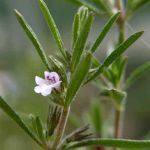| Common Name: |
Jamaican Peppermint |
| Other Names: |
Costa Rican Mint Bush |
| Genus |
Satureja |
| Botanical Name: |
Satureja viminea syn. Micromeria viminea |
| Family: |
Lamiaceae |
| Native Location: |
West Indies |
| Cultivation |
Well-drained to dry, neutral to alkaline soil in sun. Satureja douglasii needs moist, sandy, slightly acid loam, and partial shade. Pinch out new shoots in spring to encourage bushiness. Cut back perennials in early spring. Winter crops of S. hortensis may be grown in pots in greenhouses at 7-10°C (45-50°F) or from seed sown in early autumn; it reputedly deters Mexican bean beetles if planted along rows of legumes. |
| Propagation |
By seed sown in spring at 13-16°C (55-61°F); by division in autumn or spring (perennials); by greenwood cuttings in summer (shrubby species). |
| Harvest |
Leaves are harvested during the growing season. Flowering tops are picked in summer. Both are used fresh, or dried for infusions and oil extraction. |
| Height: |
1.5m (5ft) |
| Width: |
1m (3ft) |
| Hardiness |
Min. 7°C (45°F) |
| Parts Used: |
Leaves |
| Properties |
An aromatic herb that improves digestion. It has a pennyroyal-like scent. |
| Medicinal Uses: |
Leaves mixed with ginger as a remedy for colic (Costa Rica) |
| Culinary Uses: |
Leaves are used to flavor meat (Trinidad). |
| Bibliography: |
Encyclopedia of Herbs by Deni Bown Copyright © 1995, 2001 Dorling Kindersley Limited. pp 361-362 |

